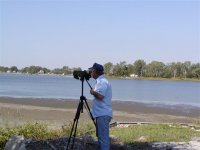Larry Lade
Moderator
September 24, I birded the area south of Saint Joseph this morning. I was plesantly surprised to see quite a few water birds on Mud Lake. The first birds I noticed were 28 Cattle Egrets on a low island in the middle of the lake (some of them were still sporting their brownish tinged breeding plumage), one Snowy Egret was in their midst and two more snowies were away from the flock of resting egrets and attempting to catch breakfast. There were six American White Pelicans, one Double-crested Cormorant, 20 Canada Geese, 32 Blue-winged Teal and seven Pied-billed Grebes in the same general area. On Lake Contrary proper I found one White-faced Ibis feeding in the watery vegetation at lake side and a few ducks hiding in the vegetation. This year we have unsuitable habitat for shorebirds (waders) and the only ones I saw were a couple of Killdeer and one Pectoral Sandpiper. Ring-necked Ducks usually do not show up until November, so the one adult male I saw on Lake Contrary was also a surprise.
Away from the water I observed five Yellow-rumped Warblers, five Eastern Bluebirds and a late departing Lark Sparrow (most of his/her kin left three or four weeks ago). All in all a pretty good day to be out birding!
Larry
Away from the water I observed five Yellow-rumped Warblers, five Eastern Bluebirds and a late departing Lark Sparrow (most of his/her kin left three or four weeks ago). All in all a pretty good day to be out birding!
Larry






